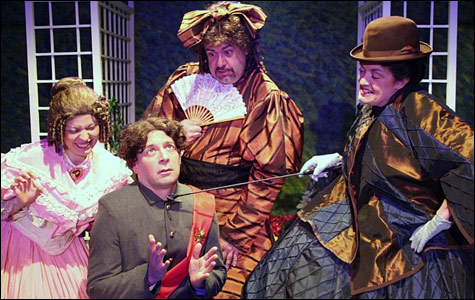
VALHALLA: A demanding sprawl of silliness.
|
From Shakespeare to Shaw, statues have come to life on stage. But until Noah Haidle’s Persephone (presented by the Huntington Theatre Company at the Calderwood Pavilion through May 6), none has conversed with a rat (unless you count Don Juan). Haidle, however, has less in common with the dead white masters than with his teacher, Christopher Durang, with whom he shares an arbitrary, absurdist sensibility. The 28-year-old writer has already penned half a dozen plays with wildly imaginative premises, including Mr. Marmalade, whose four-year-old heroine has an abusive businessman for an imaginary friend, and Vigils, in which a widow keeps her dead husband’s soul trapped in a box. Princess Marjorie, like Persephone, has roots in classical mythology. But Haidle is adamant that he isn’t out to say anything, and in the oft-entertaining Persephone, which fails to earn its redemptive ending, that shows.
The play was inspired, the playwright has said, by his speculation that a statue of Goethe in New York’s Bryant Park had rather a dull time of it watching kids go up and down on a nearby carousel all day long. This appears to have set him thinking about a number of big themes, including the misery of the world, the mercilessness of mortality, and the power of art. I would suggest that he hasn’t thought hard enough, or even tried to, preferring to launch piquant notions into the æther and watch them playfully and nastily collide. The reason that Persephone delighted more as a staged reading in last spring’s Breaking Ground Festival of new-play readings than it does in full production — even a visually tricked-out, well-acted one helmed by Durang specialist Nicholas Martin — is that it’s highly original but sketchy. Haidle has a knack for mixing whimsy and tragedy, but in Persephone, at least, he doesn’t know where to take the bubbling concoction once he’s whipped it up. In the play’s second act the blender just whirs and whirs, then explodes in a burst of gold confetti and spring flowers — a theatrical allusion to the myth of Persephone that’s no payoff.
Like David Mamet’s Glengarry Glen Ross, Persephone boasts two differently structured acts that nonetheless cohere. Act one is set in 1507 Florence, where the central character, a statue of the goddess Demeter, is under construction. Giuseppe, her young creator, is struggling with the shoulder from which the harvest goddess extends her arm to Persephone, the daughter who gets abducted to the Underworld by Hades. Giuseppe is also struggling with a couple of relative philistines: the model Celia, who has made the rounds from Botticelli to Michelangelo, probably servicing more than their “vision,” and the patron Alfonso, who has commissioned the statue to guard the tomb of his recently deceased daughter. As for the maternal icon herself, this Demeter yearns less for Persephone than for Giuseppe, whose corruption by the carnal world represented by Celia and Alfonso breaks her heart. But it’s a tough planet, Demeter is informed by the only character who hears her thoughts: a mouse who turns up to scrounge a bit of cheese and tell the lofty artwork that beauty’s fine but it won’t feed your belly or keep folks from stepping on you.
During intermission, as Demeter reports, 500 years pass; the present finds her presiding from her pedestal in a New York City park, unwilling witness to a parade of human misery, crime, and corruption as well as helpless victim of defacement, acid rain, and a rain of pigeon droppings. “If only I could look away,” she continually moans, “that would be heaven.” Here the actors appear and reappear as a cornucopia of craven or unhappy caricatures, including prostitutes, drug dealers, vandals, crazies, a bad cop looking for any blow job he can get, and a sad mortal version of Demeter herself: a woman whose daughter was raped and murdered at the statue’s feet. This aching soul visits daily to chat up and wash off the monument she considers the only thing of beauty in her ruined life. The view of art in the animal kingdom, however, has looked up: Demeter’s present communicant is a rat who spends his free time skittering about the Metropolitan Museum amid as many as 20,000 dangerous feet. Before abruptly and hilariously surrendering to mortality, he marvels that “out of all this horror man has made so many beautiful things.”
If only Haidle had explored more deeply — and less repetitively — his central metaphor. Act one is funny, but too much of the humor derives from anachronistic language and sexual situations. And act two is a grotesque cartoon of an urban landscape gone horribly wrong. No wonder Demeter wants to close her marble eyes; she cannot, after all, expect the mythological rescue with which the play ends. This is not to say that Persephone is not enjoyable in its smutty, whimsical way, just that it’s unsatisfying. The play is beautifully lit by Ben Stanton, with an eye toward the endless recycling of the days, but the sets by David Korins are too literal for Haidle’s non-naturalistic vision. Melinda Lopez, a last-minute replacement, makes a marvelously earthy statue, the folds in her personality less studied than those in her robe. Mimi Lieber is adorable as the vampy Celia and wrings unexpected poignance from the grieving mom of the second act, wielding her vigilante attack on Demeter’s tormentors. Seth Fisher combines moony comedy with toughness, and the always reliable Jeremiah Kissel crosses both centuries and species with aplomb.